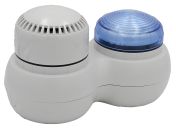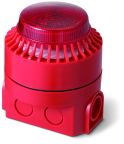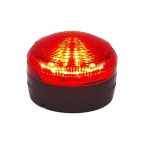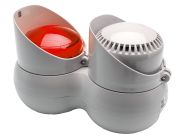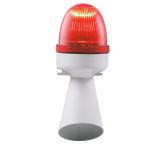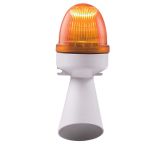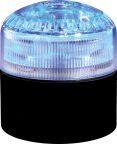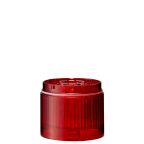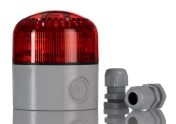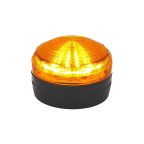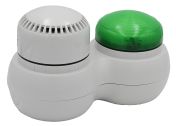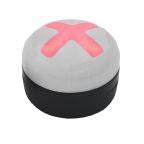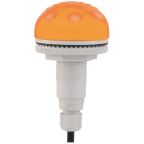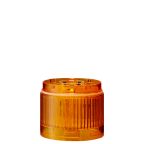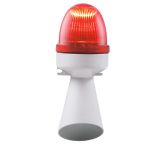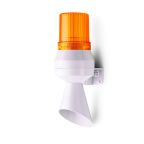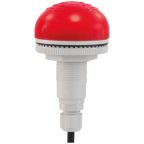Sounder Beacons
An electronic sounder and beacon is an alarm device with both audio and visual properties, typically used in emergency situations such as fire alarms for evacuations or on emergency vehicles to alert road users. The sounder emits a loud audible alarm to warn of hazards, while the beacon provides a clear visual alert, usually through a flashing light with a coloured lens.
Conventional sounder beacons are widely used in commercial and industrial sectors and found in public places like schools, warehouses, offices, construction sites, laboratories, and industrial parks. These devices are crucial during emergencies like fires, earthquakes, or other natural disasters, signalling people to evacuate and take necessary precautions. They also serve non-emergency purposes, such as controlling traffic or alerting workers to potential hazards at factories and construction sites.
How Do Sounder Beacons Work?
Sounder beacons can be triggered manually, such as by pressing a button, or they can activate automatically in response to specific conditions, like the activation of a fire alarm or the detection of a gas leak. They may be powered by electricity or batteries, depending on the application’s requirements.
The audio and visual alarms in sounder beacons are integrated, making them enhanced warning devices. They can emit different tones, incorporating high, low, and industry-standard frequency patterns. Additionally, they feature various coloured lenses to improve the warning signal. A wide range of sounder beacon options is available for both indoor and outdoor use, some equipped with volume control and tuneable features.
Beacons may use halogen bulbs, similar to those in xenon flash tubes or LED floodlights. Types of sounder beacons include flashing beacons, which use flashing lights to attract attention, and rotating beacons, which create a strobe effect with a spinning light. Some sounder beacons also include a speaker or other audio component for broadcasting alarms or warning messages.
What's the Coverage Area of a Sounder Beacon?
Typically, the audio range of a sounder beacon is between 5 and 15 decibels (dB (A)) above the ambient noise level. When determining the coverage area of an electronic sounder and beacon, it’s essential to consider factors such as background noise from people or machinery.
Sounder beacons should always be used in conjunction with other safety measures and should not be relied upon as the sole means of alerting people to potential danger. Additionally, it is crucial to follow established evacuation and safety procedures in the event of an emergency.
Types of Sounder Beacons
Sounder beacons come in various types to suit different applications and environments. Here are some common types of sounder beacons:
- LED Sounder Beacons: These modern devices use Light Emitting Diodes (LEDs) for visual signaling. LEDs are energy-efficient, long-lasting, and provide bright, attention-grabbing light. They're ideal for environments where power consumption is a concern or where frequent maintenance isn't feasible.
- Xenon Sounder Beacons: These units feature xenon strobe lights, which produce intense, brief flashes of light. Xenon beacons are particularly effective in high-visibility applications, such as industrial settings or outdoor areas where ambient light levels may be high.
- Alarm Sounder Beacons: These devices typically produce a loud, continuous, or intermittent tone along with a flashing light. They're designed to grab attention quickly and are often used in fire alarm systems or industrial emergency situations.
- Buzzer Sounder Beacons: Buzzer-type devices emit a distinct buzzing sound along with visual alerts. They're often used in less critical applications or where a different sound from traditional alarms is desired, such as in some manufacturing processes or building management systems.
- Electronic Sounder Beacons: These versatile devices use electronic circuits to generate a wide range of sounds and tones. They can often be programmed to produce different audio patterns for various alert levels or types of emergencies. The electronic nature also allows for volume control and sometimes even voice messages.
When selecting a sounder beacon, it's important to consider factors such as the environment where it will be installed, the type of emergencies it needs to signal, the ambient noise and light levels, and any specific regulatory requirements for your industry or location.
Why Choose Sounder Beacons from RS?
At RS, we offer a broad range of robust sounder beacons to fully suit your needs. Our inventory includes combined sounder and beacon products, such as Klaxon sounder beacons, Eaton sounder beacons, Flashni sounder strobes, and alarm sounder beacons from reliable brands like e2s, Werma, Patlite, Schneider Electric, and Moflash. Additionally, we feature our own versatile RS range, specially designed and rigorously tested to meet high industry standards for maximum longevity, efficiency, protection, and ease of installation. Our RS PRO audio-visual alarm solutions ensure you have the best options for reliable and effective warning systems.
Delivery Information for Singapore
RS offers prompt delivery of electronic sounders and beacons, along with items like wall-mounted sounders, electronic alarms and pressure sensors, within Singapore. For online orders placed between Monday and Friday before 3:30 pm, next-working-day delivery is available if the items are in stock. For more details on our full range of delivery options, including offline orders and consolidated shipments, please visit our delivery information page for comprehensive guidance.
Popular Searches
Related links
- Electronic Sounders
- Eaton Deep Base for use with Flashni, RoLP Sounder Beacons
- Eaton Powered Base for use with Flashni Sounder & Beacons
- Eaton IP65 Rated White Powered Base for use with Flashni Sounder & Beacons 264 V ac
- Alarm Sounders & Alarm Strobes
- Automation Signalling
- Eaton Cover Plate for use with Squashni Sounders
- Schneider Electric Gasket for use with DIN96 Electronic Alarm
